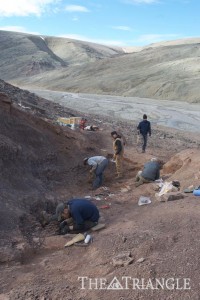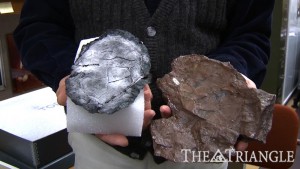Researchers at the Academy of Natural Sciences of Drexel University recently discovered a new species of fish fossils, Holoptychius bergmanni, that could reveal more about the evolution of some aquatic organisms that are now land organisms.
Led by Ted Daeschler, associate curator of the Academy’s Department of Vertebrate Biology, and Neil Shubin, a researcher and professor at the University of Chicago’s Department of Organismal Biology and Anatomy, the team worked together to analyze new findings both locally in Pennsylvania and in Arctic Canada.
“[The fossils are] helping us paint a better picture about the diversity of life,” Daeschler said.
Their research strongly focuses on a set of organisms rooted in the Devonian period, a time set around 100 million to 365 million years before our time. “It’s important to highlight the late Devonian as a time of real transition in not only the history of vertebrates but also the history of arthropods and plants. The Devonian period is a time when terrestrialization is happening in a big way across a number of different groups. It’s the dawn of the modern terrestrial ecosystem,” Jason Downs, a research associate from Swarthmore College who worked with Daeschler and Shubin as lead researcher in their most recent project, said.
In 1999, Daeschler partnered up with Shubin to go well above the Arctic Circle to look for Devonian rocks in an area called Nunavut.
“There are good Devonian rocks that were formed in kinds of environments that would have these kinds of fossil fish. The rocks are well exposed because we don’t have as much soil or plant growth as we do here in Pennsylvania, and the area hadn’t been explored yet before,” Daeschler continued. Since then, Daeschler has gone back to the area seven times. It is also where he found the most information for his most recent publication.
“The H. bergmanni material was collected at a locality on Ellesmere Island [in Nunavut, Canada] that I discovered back in 2000. The locality has been quite productive, supporting five field seasons since its original discovery,” Downs said. Downs was part of the small research team of four scientists that had worked in the area for the last decade. He was the lead researcher and author of the publication on H. bergmanni, the third new species to be found in that area.
“Oftentimes it’s very hard to find the whole skeleton. Most of the time we find the most durable parts of the skeleton. When the animals had died, most of the body was destroyed. The best parts to find are the jaw line and parts of the skull,” Daeschler said.
After the material is collected from the site, it is taken to a preparation lab where the rock is slowly chipped away from the bone to remove the embedded fossil. It exposes the details of the fossil to be studied later. The fossil is then compared to other fossils, related animals and other papers.
H. bergmanni was found in the same area as Tiktaalik roseae, a famous fish fossil found in 2006 by Daeschler, who described it as a “textbook example” of vertebrate transition to terrestrial ecosystems. Research into the fossil gave not only an anatomical analysis but also an ecological indication.
“It seemed to be doing some novel things with its fins and the nature of its skeleton, particularly in the neck. It was taking on some novel features that we don’t associate with a fish. It was starting to live more like an amphibian with appendages that helped it get around shallow water or a neck that moved from side to side,” Daeschler said.
The research team discovered that the fossil was not only a member of the group Holoptychius but was also a new species of that same group.
Furthermore, the researcher compared the H. bergmanni to other members of the genus that were found in different areas of the world. Daeschler described this as paleogeography.
“Some of the closest relatives of the specimens we found in Canada are known in Europe, in the Baltics, in Latvia, also in Scotland. It helps confirm that there was no Atlantic Ocean at the time. The landmasses were conformed much more differently,” he said.
Downs had been working with Daeschler and Shubin for almost 20 years; he began working as a high school intern. The research will continue to analyze H. bergmanni and compare it to other members of its genus. “It really redefines how we use the name Holoptychius,” Downs said.



